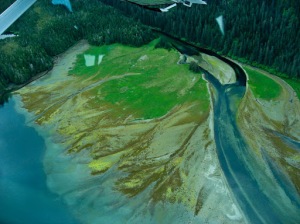Flightseeing: Baranof & West Chichagof
Here’s some of the pictures from the flightseeing trip I got to sit in on earlier this month. In the last couple weeks things have suddenly been real busy, and I have a couple more sets of pictures in the pipeline.
This flightseeing trip was with some folks from the Alaska regional office of The Wilderness Society, who were showing their Senior Vice President of Conservation around the state, to see how awesome it is. TWS contributed funding for my position, so I got to go along for a bit.
We took off in a floatplane (a De Havilland Beaver, I believe) and headed west from Sitka towards Mount Edgecombe, which is picturesque, except that it was shrouded in clouds. Although we couldn’t see much of the high elevation sights, there was plenty to look at on the lower levels. For instance, here’s what happens on the land that is disturbed by logging roads and such.

All the rounded green texture is red alder, which moves in along the logging roads. It grows fast, and isn’t as commercially valuable as the spruce, hemlock or cedar. Below you can see the line of a road along the left side, then yellow green is new conifers growing back. On the right side you can see some uncut forest. It is speckled with gray – that’s yellow cedars which died up to eighty years ago, but which stay standing. When I first flew into Sitka, I assumed the dead trees were victims of the spruce bark beetle, which wreaked havoc in my home region, the Kenai Peninsula, but that’s the not the case at all. As the post glacial landscape here continues to evolve, or because of climate change, or because of the natural lifespan of a yellow cedar, they die. The wood is exceptionally resistant to decay and bugs (think cedar shavings, cedar chests, cedar homes), so it takes decades for the trunks to fall over.

In addition to flying over old and young growth forests, we flew over a lot of muskeg and a lot of coastline. From above, this beach looks about like places I saw on the Big Island in Hawaii last month, unless you can see its a conifer forest, not a jungle. Colder water, too!

Although the Tongass National Forest is well known for its trees, half of it is not forested at all. There are mountains and muskegs and rivers and lakes, but now that I’m here I see that a dominant characteristic is shoreline. Geographically, this area is the Alexander Archipelago, made up of thousands of islands.


The above group of islands is appropriately called the Myriads. I’m told the ones on the outside edge host a sea lion colony, which makes a ton of noise if you’re camping nearby.
Below is another important piece of the coastal ecosystem – an estuary. Where a freshwater river runs out into the sea, spreading out sediments, making new land for lots of green things to grow on. In the spring and early summer (i.e. now) the bears come down to these areas to eat grasses in the estuaries. Later in the year the bears will be back to these areas, of course, when the salmon arrive and start heading upstream.
 When we were in Hawaii, driving through the lush tropical jungle, there was a place where the guidebook claimed we would see shades of green we’d never seen before. Seeing these estuaries, I don’t think Hawaii has a monopoly on vivid greens.
When we were in Hawaii, driving through the lush tropical jungle, there was a place where the guidebook claimed we would see shades of green we’d never seen before. Seeing these estuaries, I don’t think Hawaii has a monopoly on vivid greens.

We flew up the coast of West Chichagof and Yakobi Islands, a big chunk of which is a Wilderness Area, and counted about five boats. Then we cut across West Chichagof to Chichagof proper and stopped at a spot called Sitkoh Lake, which will be a restoration area soon. There are two Forest Service cabins on the lake, and we stopped by one of them and took a little walk in the marshy area at the head of the lake.

There were a lot of deer tracks in the mud, including some from a fawn that were absolutely tiny – about an inch long! We mucked about in the fen, and I decided that definitely needed to get on it and buy a pair of extra tuffs, the ubiquitious brown rubber boots that are called Sitka slippers if you’re in Sitka, or Ketchikan slippers if you’re in Ketchikan and probably Juneau slippers, Petersburg slippers, Kodiak slippers, too.
I saw a bit of movement down in the vegetation and found a toad, which everyone else took pictures of. He was two or three inches long, and had some yellow spots on his feet, but I couldn’t take a picture, because I was holding him, so here’s a wildflower that likes wet areas, called a shooting star, instead. Imagine the toad sitting underneath it, telling stories to his grandkids about the time he was captured by giant monsters with dry skin and flashing lights.

Back in the plane, they all insisted that I should sit in the front, so I got a good view. We flew across the mountains of Baranof Island back to the side that Sitka is on, but it was a lot of clouds that don’t make for good pictures. Here’s another verdant estuary, though.
Here’s Sitka from the air. The main town is on the left; the airport is on the island on the right.

I’m pretty sure that they artificially extended the island to make the runway.
So that’s the flightseeing. If you ever find yourself up here and want to go flightseeing, then the folks at Harris Air are the ones you want to talk to.


